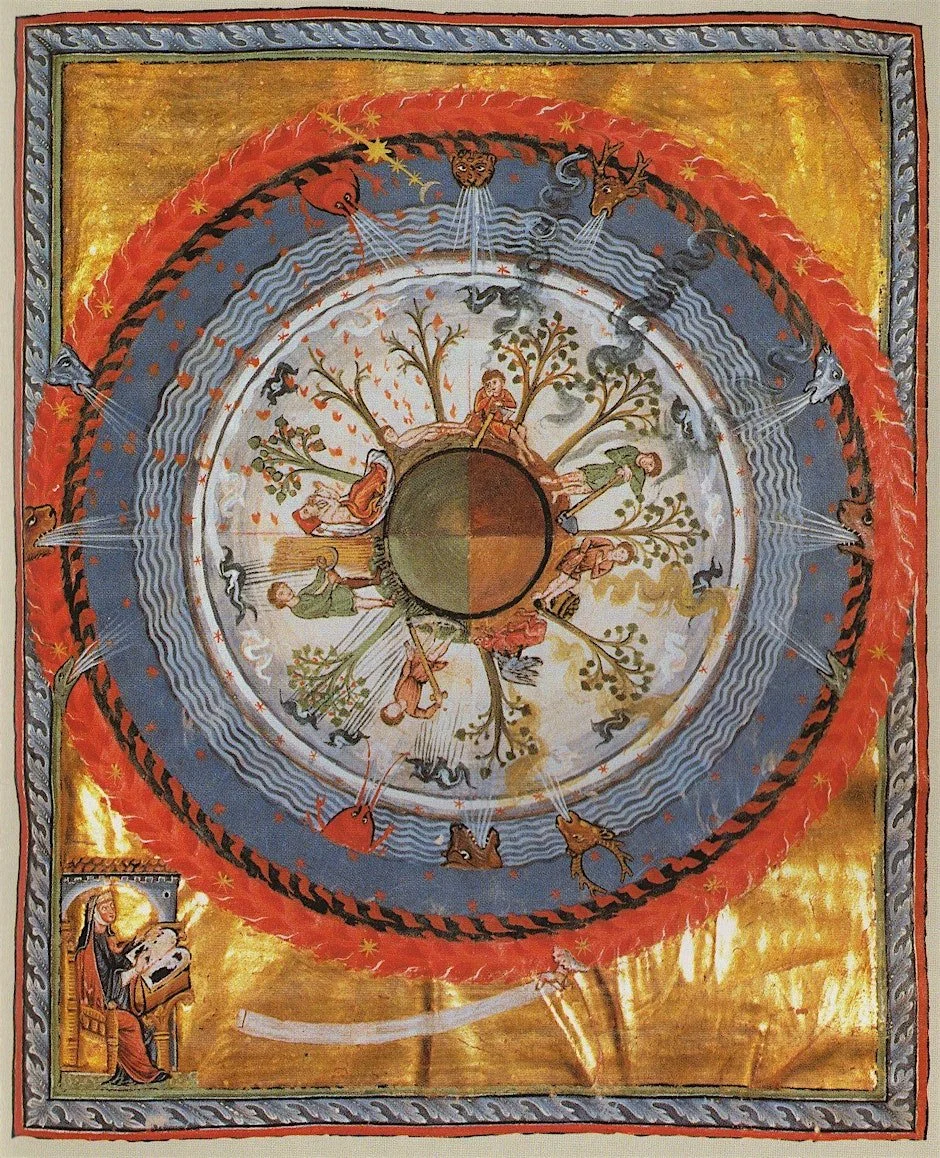The Mystic’s Vision:
Hildegard’s Chants to Soul and Nature

First Congregational Church of Los Angeles
540 South Commonwealth Avenue Los Angeles, CA 90020
Saturday September 20th, 2025
A reimagining of Hildegard Von Bingen’s ecstatic chants in a celebration of the relationship between nature and the human spirit.
-
In the last 20 years there’s been a surge of interest in Hildegard, in part because of her official recognition as a Catholic saint, but also because of her elevation as a doctor of the church – a prestigious title reserved for those who have made substantial theological contributions to church doctrine.
Outside of her spiritual qualities as a mystic visionary, Hildegard stood out as a writer, scientist, and religious leader. Her output is such that she doesn’t just stand out in the middle ages when women were rarely known as writers or leaders, but really for any time. Here is a brief list of her accomplishments:
Hildegard regularly corresponded with European rulers and church leadership, including the pope, many of whom sought her council in both personal and political matters. She wrote two biographies of saints, two books on healing, one a medicinal guide, the other a physician’s guide compiling the medical knowledge of her time, as well as three books describing her mystical visions. These books of visions are accompanied by lengthy interpretations of each vision, paintings she created to illustrate them, as well as original poems and songs, including what many consider to be the first European opera.
In fact, of the medieval composers whose work we still have today we have more pieces from Hildegard than anyone else, an impressive body of compositions that uncommonly included original text and influenced the development of polyphony. Oh, and she once invented her own language - just for fun.
But it is her mystical visions and cosmic theology, a theology that paints a tightly interconnected world between God, humans, and the Earth, that I believe has fueled her resurgence today.
Hildegard saw a unity between the earthly, the heavenly, and the in-between mirrored by the co-equal, three-in-one quality of the holy trinity. She spreads traditional monotheistic hierarchies horizontally by finding the Trinity reflected in all aspects of creation: its physical embodiment, its holy nature, and its divine spark. This unity, a recurring theme across her theology, music, and medicinal practice, is a reflection of the divine order. Not a static order reminiscent of a Platonic ideal, rather it is a generative order that lives, breathes, throbs, expands, blooms, and drips with life.
If that seems overly sensual, I assure you Hildegard understood the erotic nature of the divine. Look at her painting “The Cosmos” and you’ll see a decidedly feminine depiction of the universe. Georgia O’Keeffe has never painted a more obvious…flower.
Consciously or not, Hildegard’s work was deeply feminist, but not in a political or social way. Rather, she claimed femininity as an integral part of her theological cosmos, the central aspect of an active creation, one which overflows with verdant life, an idea she called Viriditas.
Viriditas is a difficult concept to talk about, but it’s not hard to understand for anyone who has spent time alone in the wilderness. The word translates to “greenness” or “greening” and it speaks to the fertile energy of the universe as a central part of God’s, and our own, creative vitality. Viriditas is the flourishing energy that we share with the living earth, that connects us to it as a creation of creation.
Viriditas is a philosophy that not only elevates the physical world as an equally divine facet of creation, it resists the denigration of the body as inherently sinful. The humblest aspect of the world, the smallest creatures and plants, the loam of the earth, our own physical beings, are all shaped by the hand of a loving God who has imbued each of these things with its own essence, and we are invited to enjoy its pleasures. As Khalil Gibran wrote,
“Forget not that the earth delights to feel your bare feet and the winds long to play with your hair.”
There is an erotic intimacy between humans and the divine in our cultivation of the earth where we get to touch, consume, put our hands on and even inside the fertile soil of creation. If I may bring together two pieces of Hildegard’s writing:
“The soul” she writes, “is kissed by God in its innermost regions…’With my mouth,' God says, 'I kiss my own chosen creation. I uniquely, lovingly, embrace every image I have made out of the earth’s clay. With a fiery spirit I transform it into a body to serve all the world.”
This is our gift, to be the loved creation of a loving creation. We have such Viriditas in us, and we harness it too, participating in creation as creators, both the created and creators of creations. What a wild reality to embrace and contend with, what a privilege and what a responsibility to be made in the image and endowed with the power of creativity itself.
Performers
Laurel Irene
Laurel Irene, “astounding…downright superhuman” (LA Times) vocalist, brings a collection of Hildegard’s chants to life, illuminating her unique relationship with nature and the human spirit. Staging, live electronics, and novel instrumentation including The Great Organs at FCCLA creates sonic textures that enfold Hildegard’s ecstatic mysticism. “The Mystic’s Vision” draws its structure from Hildegard’s scientific writings in which she explores quadral structures to explain the interconnectedness of humans with nature and the cosmos. Irene and collaborator David Harris create an intimate performance space where ritual-driven staging intuits connections between Hildegard’s music and poetry and her scientific understanding of creation. The performance is part sonic meditation and part electricity for the ears all wrapped in some of history’s most enticing melodies and poetic expressions.

